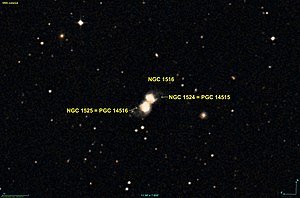NGC 1525
| Galaxy NGC 1516B / NGC 1525 |
|
|---|---|

|
|
| AladinLite | |
| Constellation | Eridanus |
|
Position equinox : J2000.0 , epoch : J2000.0 |
|
| Right ascension | 04 h 08 m 08.3 s |
| declination | -08 ° 50 ′ 09 ″ |
| Appearance | |
| Morphological type | Scd? pec |
| Brightness (visual) | 13.8 mag |
| Brightness (B-band) | 14.5 mag |
| Angular expansion | 0.9 ′ × 0.7 ′ |
| Position angle | 126 ° |
| Surface brightness | 13.1 mag / arcmin² |
| Physical data | |
| Redshift | 0.032903 ± 0.000150 |
| Radial velocity | (9864 ± 45) km / s |
|
Stroke distance v rad / H 0 |
(437 ± 31) · 10 6 ly (134.1 ± 9.4) Mpc |
| history | |
| discovery | Ormond Stone |
| Discovery date | December 31, 1885 |
| Catalog names | |
| NGC 1516B / NGC 1525 • PGC 14516 • MCG -02-11-018 • | |
NGC 1525 = NGC 1516B is a spiral galaxy of the Hubble type Sc in the constellation Eridanus in the southern sky . It is estimated to be 437 million light years from the Milky Way and forms an interacting pair of galaxies with NGC 1524 .
The object was discovered by Ormond Stone on December 31, 1885 . However, the pair of galaxies had already been observed by Wilhelm Herschel.
